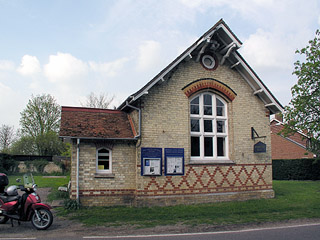This is an unfortunate corner of the county as far as churches are concerned. The medieval church of Wendy was pulled down in the 1850s, while the sister parish at Shingay lost its church in 1697, never to be rebuilt. According to Pevsner there was also once a Preceptory of the Knights Hospitaller at Shingay - again, that has been lost.
You'd be forgiven for concluding that Wendy's church was not rebuilt either. We were most confused as we drove through the village - there was a grand house that looked like a 19th century vicarage, and a graveyard, and a village hall, but we saw no sign of any church - even an insipid little Victorian neo-gothic affair. Eventually we stopped at the village hall to see if there was a sign on the noticeboard telling us where the church was. But the sign on the board said that this was All Saints.
Far from being a village hall, this utilitarian yellow brick hall is the replacement church. One reason that it doesn't look much like a church is that it hasn't actually been one for very long, having been the village school until the 1980s. The medieval church was replaced - on the same site, in the graveyard just up the road - by a structure built in 1867, but that fell down in the 1930s. All of this was told me by Steve Robinson and Shamus Williams, who kindly e-mailed us to correct an earlier version of this page. The ill-luck of churches built in the graveyard seems to be down to a number of springs which rise in the ground on which they were built - Steve notes that even now, 'graves dug in the churchyard fill up with water in minutes and the coffins used to be held down with poles until the dirt would keep them down.' No wonder their churches don't stay up!
None of this was evident to us on our first visit, of course, so we stood looking at this rather odd building claiming to be All Saints and felt a bit bemused. Needless to say, the door was locked and there was no indication of any keyholders. Scrabbling around rather desperately for things to write about, I noticed that the brickwork over the west window was rather nice - interlocking lines of red and yellow bricks, with a layer of black bricks over the top. It would look very nice on a large suburban house somewhere in Haringey.
Why was All Saints rebuilt in this way? There are several churches in the county that were built in the 19th century, but none of them as feebly as this. Perhaps the congregation was especially low church, or there was no money available?
I shouldn't be too harsh - the church is still in use, and a church needn't be either beautiful or ancient to fulfil its function. [Mark adds: I poked the camera up over the high sill to take a shot of the inside of the church - you can see the result on the right. It reminds me of a village hall set out for a particularly sparsely-attended amateur dramatics club evening] Nevertheless, a village without its medieval church has lost an irreplaceable and concrete manifestation of its history. Perhaps it was my overactive imagination, but Wendy felt to me like a village without a soul - in the process of forgetting (and being forgotten by) its ghosts, and sitting uneasy on suddenly unfamiliar earth.
All Saints is kept locked.

